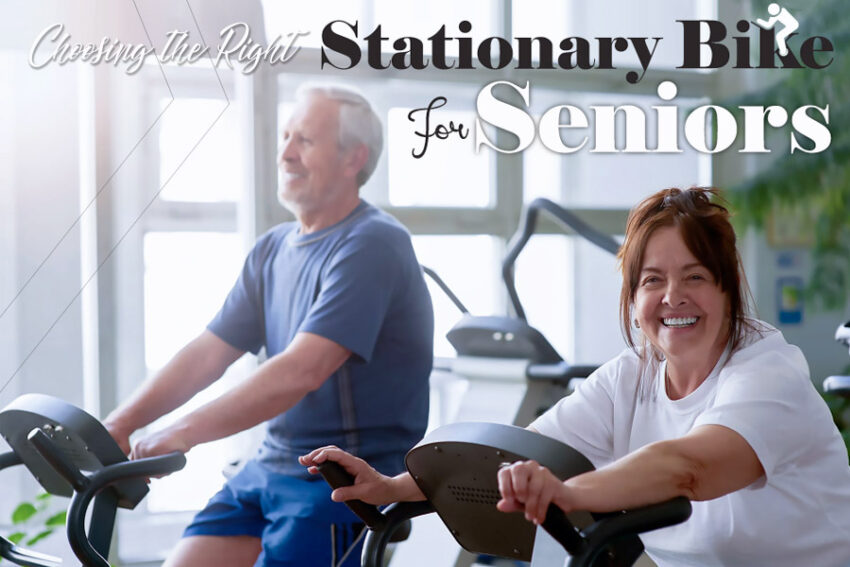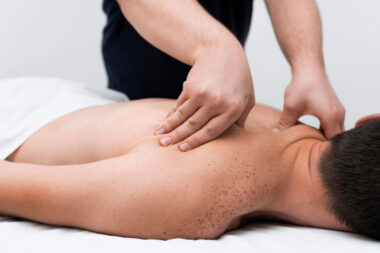Exercise is a vital component of maintaining good health, regardless of age. For seniors, staying active becomes even more essential to ensure a high quality of life. One excellent way seniors engage in low-impact, effective exercise is by using stationary bikes.
Stationary bikes offer a safe and convenient means of staying fit while reducing the risk of injury. However, with various types and features available, seniors must choose the right stationary bike that suits their needs and preferences.
Stationary Bike Categories
Before delving into the selection process, it’s essential to understand the different types of stationary bikes available:
1. Upright Bike
The most popular type is an upright bike, which has a straight-up riding position and a more petite, more compact frame that makes it suitable for seniors with limited space.
Upright bikes offer an excellent cardiovascular workout, and many models come with features like adjustable resistance levels, heart rate monitors, and pre-programmed workouts.
2. Recumbent Bike
Recumbent bikes offer a more relaxed and comfortable riding experience. Seniors sit in a reclined position with their legs extended in front of them. This design reduces strain on the back, neck, and wrists, making it an excellent choice for individuals with mobility or joint issues.
Recumbent bikes are known for their ergonomic design and the added support they offer.
3. Spinning Bike
Spinning cycles, commonly referred to as indoor cycling bikes, are made for harder, more strenuous workouts. They are frequently used in group exercise courses because they accurately simulate the feeling of riding a road bike.
Spinning bikes may be a good choice for seniors looking for a difficult workout, but they need to make sure that the resistance levels can be altered to match their level of fitness.
4. Indoor Cycling Bike
Spinning bikes and indoor cycling bikes are comparable, however, indoor cycling bikes tend to be more user-friendly and suited for home usage. They enable elders to cycle at their own pace and provide an effective cardiovascular workout.
For tech-savvy seniors, indoor cycling cycles with interactive screens and virtual training programs are a popular option.
Things & Tips to Consider When Choosing Exercise Bikes for Seniors
For a safe, pleasant, and successful workout, selecting the best exercise bike for seniors takes careful consideration of several aspects.
The following are thorough explanations of the elements and advice to think about while choosing an exercise bike for seniors:
1. Easy Mounting & Support
The ability to mount and demount an exercise bike quickly and efficiently is crucial for seniors with mobility restrictions or balance concerns. A low step-through design, like what you would see on a typical cruiser bike, is what you should be looking for in a bike.
The risk of tripping or falling is decreased by this design element, which enables people to walk over the frame rather than lifting their legs.
Additional Tips
- Think about bicycles with robust, strategically positioned handlebars. These handlebars ought to provide added stability while exercising and extra support while getting on or off the bike.
- Make sure the bike’s feet are rubberized and have a solid foundation to prevent slippage even on flat surfaces.
2. Check for a Smooth Ride
A smooth ride is essential for seniors as it reduces joint strain and discomfort. The smoothness of the ride is primarily determined by the bike’s flywheel and resistance system. Look for a stationary bike with a balanced flywheel, providing a consistent, jerk-free pedal motion.
Adjustable resistance levels allow seniors to start with low resistance and gradually increase it as they build strength and endurance.
Additional Tips
- Try out the bike to ensure the pedal motion is fluid and doesn’t cause any jarring or discomfort.
- Consider bikes with magnetic resistance systems, as they tend to be quieter and require less maintenance than friction-based ones.
3. User-friendly Console
The console or display on the exercise bike should be user-friendly and easy to read, especially for seniors. It should provide essential workout metrics such as speed, distance, time, and heart rate in a large, easily readable format.
Avoid overly complex displays that may need to be clarified for seniors to operate.
Additional Tips
- Look for a console with adjustable brightness or backlighting to ensure visibility in different lighting conditions.
- Some bikes come with preset workout programs that can add variety to the exercise.
4. Comfortable Seat
Seniors should prioritize comfort when selecting an exercise bike, as long sessions on an uncomfortable seat can lead to discomfort or discourage regular use. Choose a stationary bike with a cushioned, ergonomic seat that can be adjusted to fit different body sizes.
The seat should provide adequate support to prevent discomfort during extended workouts.
Additional Tips
- Consider adding a gel seat cover or padded bike shorts if the bike’s seat doesn’t meet your comfort needs.
- Check if the seat can be replaced or upgraded with a more comfortable option.
5. Don’t Forget the Safety
Safety should be a top priority for seniors using exercise bikes. Ensure the bike has safety features to minimize the risk of accidents or injuries.
This includes:
- A stable base with non-slip feet prevents the bike from moving or tipping during use.
- Secure foot pedals with adjustable straps to prevent feet from slipping off during pedaling.
- Properly functioning emergency brake or stop mechanism that can quickly halt the bike in an emergency.
Additional tips
- Seniors should always exercise within their comfort and fitness levels and consult with a healthcare professional before starting any new exercise regimen.
- Consider using a heart rate monitor to ensure that exercise intensity remains within safe limits.
6. Wide and Secure Pedals with Straps
Wide pedals with adjustable straps are essential for seniors. These features help ensure the user’s feet remain secure on the pedals, preventing slipping or accidents during workouts.
Wide pedals provide more surface area for the feet, improving stability.
Additional Tips
- Pay attention to the pedal size and ensure it accommodates various shoe sizes comfortably.
- Some bikes come with pedals with both toe cages and straps, providing an extra layer of security for the feet.
Benefits of Bike Riding for Seniors
Seniors can benefit significantly from biking in terms of their bodies, minds, and spirits. These advantages may lead to a higher standard of living and better general health.
The benefits of biking for elders are explained in full below:
1. Better Heart Health
Seniors who engage in regular bike riding experience significant improvements in their cardiovascular health. This low-impact exercise effectively strengthens the heart muscle, improving overall heart health.
As seniors pedal through various terrains and resistances, their heart rate increases, enhancing their overall cardiovascular fitness. This, in turn, lowers the risk of high blood pressure, heart disease, and related complications.
Consistent exercise helps to maintain healthy blood pressure levels and enhances blood circulation, providing the heart with the necessary oxygen and nutrients.
Consequently, seniors enjoy increased stamina, reduced fatigue, and a heightened resistance to heart-related issues.
Also read: Recommendations on Physical Activity for Healthy Aging
2. Improved Mood
Bike riding contributes to improved mental and emotional well-being for seniors. The physical activity involved in cycling stimulates the release of endorphins, often called “feel-good” hormones. These endorphins act as natural mood boosters, reducing feelings of depression and anxiety.
Seniors who engage in regular bike rides often find themselves in better spirits, experiencing less stress and an enhanced sense of self-worth.
Additionally, the opportunity to connect with nature, enjoy scenic routes, and soak in the sunshine during outdoor rides further contributes to improved mood and overall mental health.
3. Improved Relief from Osteoarthritis and Joint Pain
For seniors grappling with osteoarthritis and joint pain, bike riding presents a gentle yet effective form of exercise. The smooth, repetitive motion of pedaling minimizes the strain on joints, relieving discomfort.
This low-impact activity helps improve joint mobility, engaging various muscle groups without putting undue pressure on vulnerable joints.
Seniors often find that consistent bike riding helps alleviate the stiffness and pain associated with osteoarthritis, promoting a more active and comfortable lifestyle.
4. Less Bone Loss
Despite being a low-impact activity, bike riding qualifies as a weight-bearing exercise. Pedaling engages leg muscles, which in turn exert force on the bones. This mechanical stress stimulates bone growth and maintains bone density.
Seniors who incorporate regular cycling into their routines are better equipped to fend off age-related bone loss and osteoporosis.
By preserving bone density, they reduce their susceptibility to fractures and fractures that can be especially debilitating in later life.
5. Better Immune Health
The immune system’s function naturally wanes with age, making seniors more susceptible to illnesses and infections. Consistent physical activity, such as bike riding, strengthens the immune system.
Regular exercise enhances the body’s ability to ward off illnesses by promoting a healthy immune response. Additionally, it helps reduce chronic inflammation, which is linked to various age-related diseases.
Seniors who make cycling a part of their routine often enjoy improved immune health, translating to fewer sick days and an overall higher quality of life.
Conclusion
Choosing the right stationary bike for seniors is crucial in promoting their health and well-being. Seniors should consider their physical abilities, comfort, and safety when selecting a bike. Whether it’s an upright bike, a recumbent bike, a spinning bike, or an indoor cycling bike, there’s a suitable option for everyone.
Regular cycling not only provides numerous health benefits but also offers an enjoyable and convenient way for seniors to stay active.
This article is published by our independent team of health and wellness pundits that publish original and informative content to empower readers to take charge of their health and embark on a physically, mentally, and emotionally balanced lifestyle.






































Leave a Reply